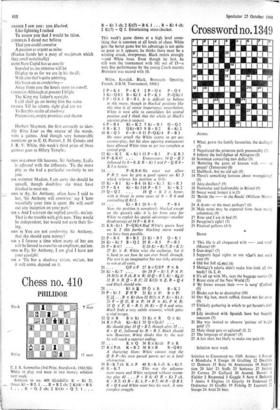Chess no. 410
PHILIDOR
Black White II men C. J. R. Sammelius (3rd Prize, Sverdlovsk, 1964/66). White to play and mate in two moves; solution next week.
Solution to no. 409 (Guidelli): K - Kt 21, threat Kt - B 5. I R - B 2 ch; 2 Kt(4) - B 6. 1 . . . R - Q 2 ch; 2 Kt(4) - Q 5. 1 . . . R - Kt 3 ch; 2 Kt(7) - B 6. 1 . . . R - Kt 4 ch; 2 Kt(7) - Q 5. Entertaining cross-checker.
This week's game shows at a high level some- thing that is common at all levels of chess. White gets the better game but his advantage is not quite so great as it appears; he thinks there must be a winning attack, overpresses. Black resists strongly —and White loses. Even though he lost, he still won the tournament with 10+ out of 15—a very fine performance by the young Czech master; Bronstein was second with 10.
White, Kavalek. Black, Bronstein. Opening, French. (I.B.M. Tournament, 1968.) 1 P-K 4 P-K 3 2 P-Q 4 P-Q 4 3 Kt-QB3 B-Kt 5 4P-KS P-QKt3 5 P-QR 3 B-Bl. It is difficult to believe in this move, though in blocked positions like this time is of minor importance; nevertheless, White is now able to consolidate his central position and I think that the whole of Black's opening plan is suspect.
6 P - B 4 Kt - K 2 7 Kt - B 3 Q - Q 2 8 B-K 3 QKt-B3 9 B-B 2 B-Kt 2 10 B-Q 3 0- 0- 0 11 P-QKt4 P-B 3 He must attack the White centre to get any counter-play, but his slow opening manoeuvres have allowed White time to get too complete a central grip.
12 Kt-K2 K-Ktl 13 P-B 3 P-KR 3 14 P-KR 4?... Unnecessary. 14 Q– Q 2 followed by 0 – 0, K R - Kt 1 and P – Q R 4 - R 5 is better.
14 . . . P-K R 4! tie must not allow P R 5: now he gets a good square on Kt 5 which relieves his position a little.
15 Kt - B 1 Kt - B 4 16 Kt-Kt 3 Kt - R 3 17 P - R 4 Kt - Kt 518 P - R 5 Kt - K 2 19 Q - Q 2 . . . 19 Q - K 2 is better, with a threat in some cases of B – R 6 and controlling Q Kt 5.
19 . . . Kt - B 1 20 0 - 0 P - B 4 Now the position is completely blocked except on the queen's side; it is far from easy for White to exploit his spatial advantage—another disadvantage of 14 P – K R 4.
21 KR-Kt 1 P-QKt4 Had White's queen been on K 2 this further blocking move would not have been possible.
22 P - R 6 B - B 3 23 Kt - B 5 Q - K 1 24 Kt - Kt 5 B - Q 2 25 R - R 5 P - B 3 26 P - B 4!? . . . If 26 Kt – Kt 7, B - K 2; 27 Kt X R. White wins the exchange, but it is hard to see how he can ever break through. The text is an imaginative but too risky attempt to win at all costs.
26 . . . QPxP 27 BxQBP P x B 28 Kt - Kt 7 . . . Or 28 P – Kt 5, P X P: 29R(5) X P ch, B x R; 30 Q – R 5, Kt – 1(4 37
31R x B, Q - B 3.1; 32 10(5) R - Q 4 and Black should win.
28 . . . Kt x II 29 (-) x B B-K 2
30 P- Kt 5 R a 11 31 Kt x P! B x P! 31 . . B x Kt then 32 R(5) X P. Kt – Kt 3; -33 P - Q 5/, R x P; 34 R x Kt, P x R; 35Q X P, K - R 1: 36 Kt - Q 6 and wins. Black finds a very subtle resource, which gains a vital tempo.
32 QxB B x Kt 33 KtxR QxKt 34 R x P ch Kt-Kt 3 35 Q xQ ch? . . . He should play 35 Q – B 2, though after 35 . . . B – Q 4!, followed by R – R 3, Black should win. However, White thinks that by the text he will reach a superior ending.
35 . . . R x Q 36 R x Ktch P x R 37 R x Pch K - R 2 38 R x B R -Q B 1 A shattering blow: White cannot stop the Q B P—his own passed pawns. act as a fatal obstruction.
39 R-K 7 ch K x P 40 R-K 6 ch K- Kt 5
41 R - K 7 This was the adjourn- ment move and White resigned without resum- ing play 41 . . . P - B 6; 42 R - Kt 7 ch, K - B 5,- 43 R - Kt 1. P - B 7; 44 R - Q B 1, K – Q 6 and White must lose his rook. A very complex struggle.














































 Previous page
Previous page